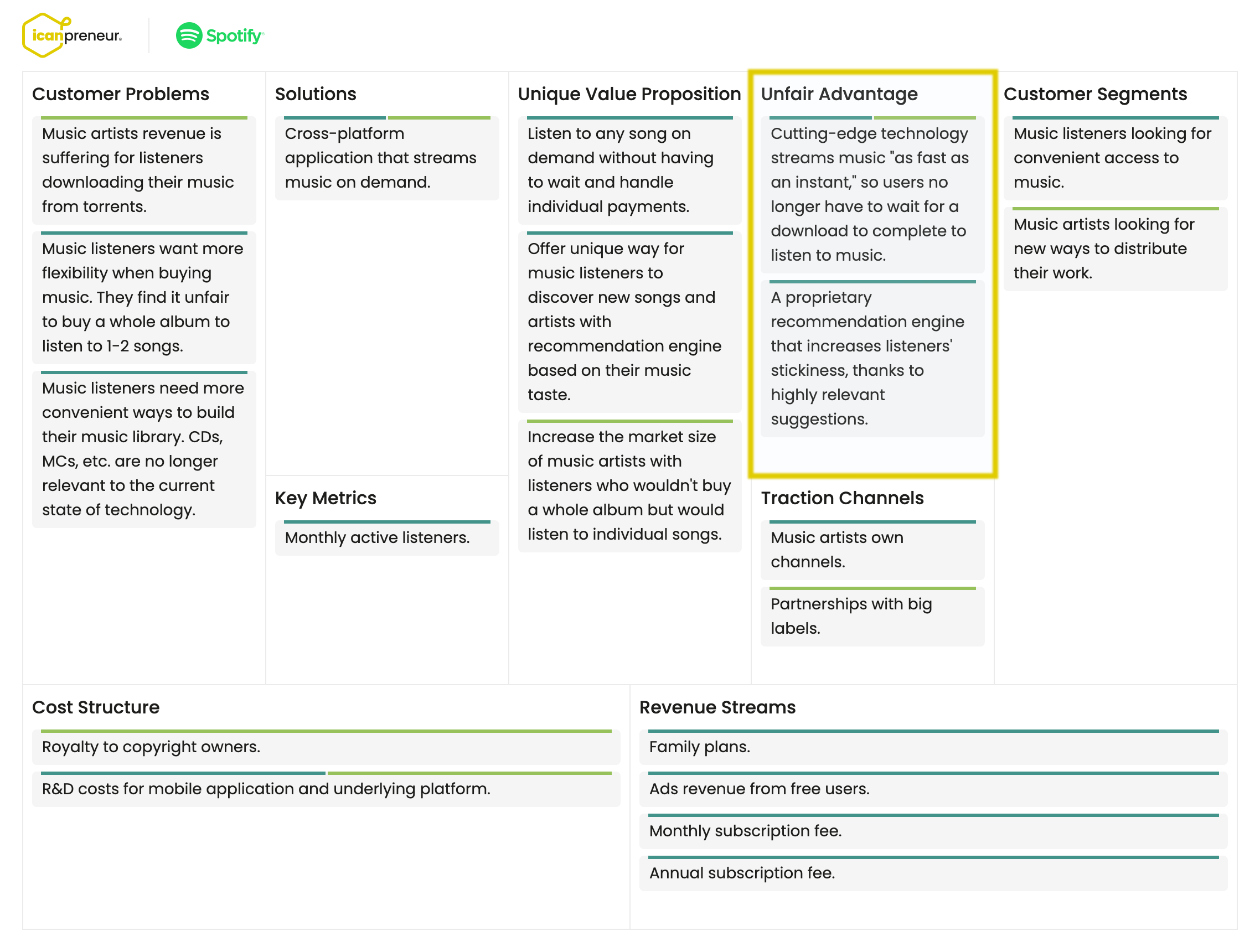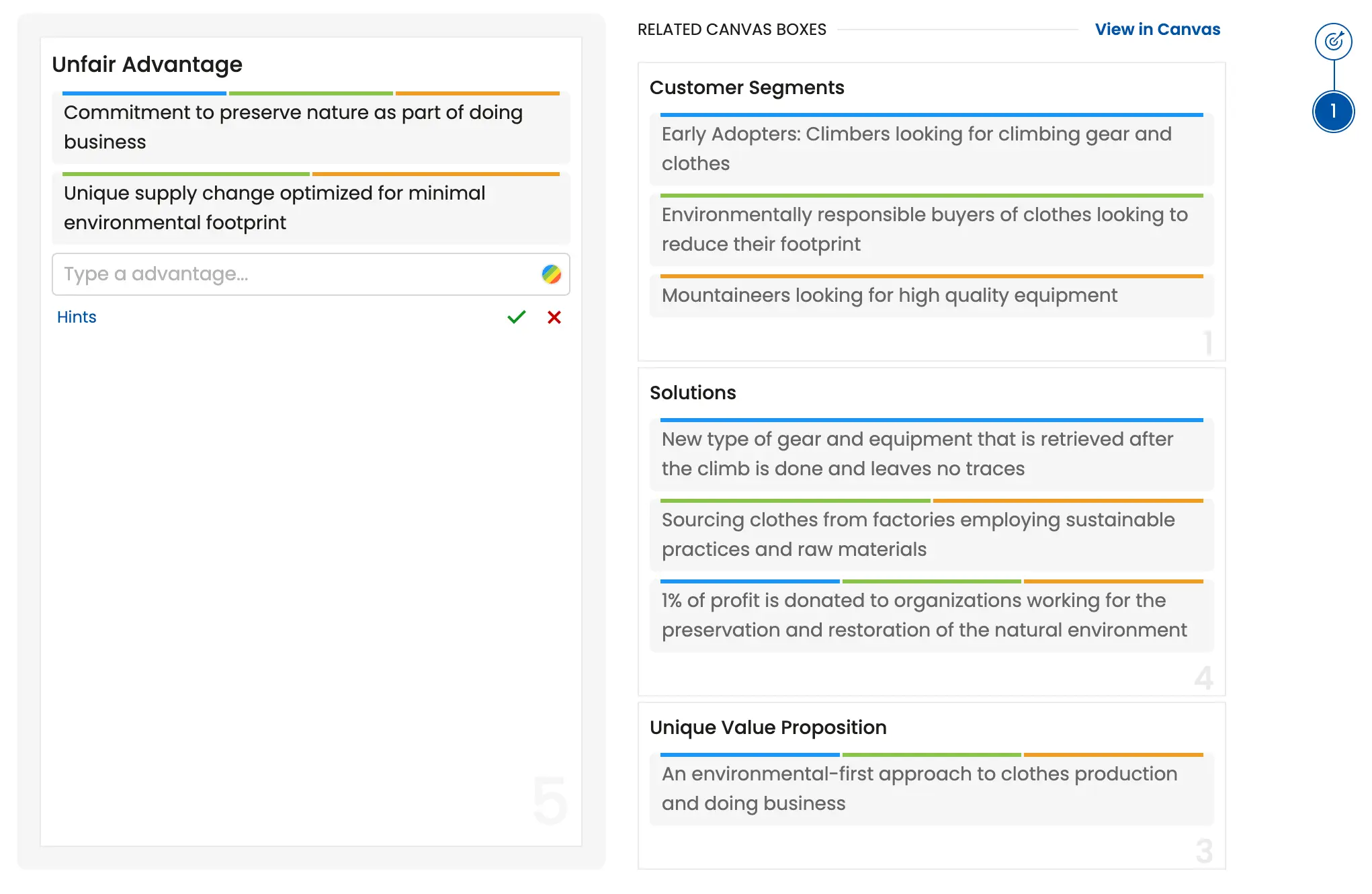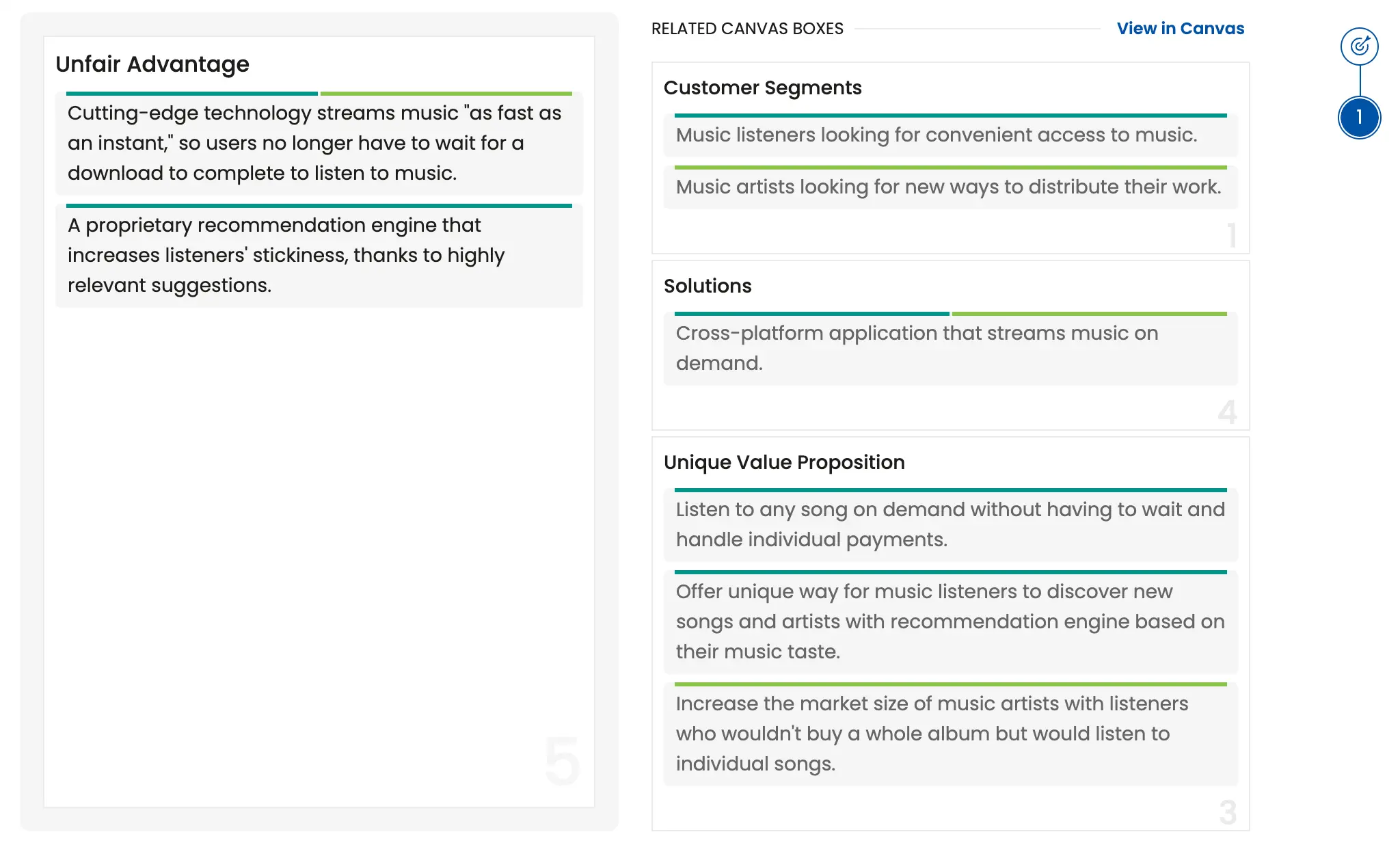Unfair Advantage: What it is and how do you find yours?
Jul 2, 2024 • 14 min read
Entrepreneurship is very competitive nowadays and continues to grow even more so. This makes it natural to keep an eye on competitors. However, many entrepreneurs overfocus on what rivals are doing, which creates many problems:
- Building in secret and delaying the moment of getting real-world feedback
- Firing up the feature mill and constantly playing the catch-up game
- Becoming a competitors-focused versus customer-centric company
One way to avoid these traps is to work and build on your product's unfair advantage. The unfair advantage’s effect will make the competitors' moves irrelevant, as it will help you win, no matter what others are doing. This allows entrepreneurs and product leaders to concentrate on their own product vision and strategy instead of chasing someone else's vision.
What is an unfair advantage in the Lean Canvas Model?
The Lean Canvas is a single-page tool with nine basic building blocks that helps deconstruct a business idea into its fundamental assumptions. It's like a painter’s canvas, allowing you to paint pictures of new or existing Business Models.
However, the Lean Canvas is never finished, unlike an actual painting. It’s a tool you can return to and refine as you learn new things. It's a tool representing your thinking about the idea you are testing at any given time.
The Unfair Advantage is one of the building blocks of the Lean Canvas. It's usually referred to as the fifth element to fill-in although working with the Lean Canvas doesn't need to be a linear activity and you can go back and forth multiple times.

Competitive advantage and unfair advantage
Competitive advantage is what sets your product apart from competing products and alternatives. It can be any aspect of the interaction of your customers with your company:
- Business model
- Customer service
- Product quality
- Product features
While all of these can help win customers, competitors will likely quickly catch up and build similar capabilities into their offerings.
Unfair Advantages give your product or service an edge over the existing alternatives. Unlike competitive advantages, unfair advantages are defensible. They are hard to replicate and unique to your product.
While competitive advantages might shift as the market evolves, unfair advantage provides more durable and long-term leverage.
5 Real-life Unfair Advantage Examples
1. Patagonia
Patagonia is an interesting example from the clothing industry. Most players in that market follow the fast fashion trend, which means:
- cheap (often harmful) labor practices,
- obsoleting clothes quickly through frequent collection releases,
- low-quality materials that quickly become unusable.
Patagonia went in a completely different direction by declaring they don’t want customers to buy their clothes. They designed a special repair program to discourage consumers from buying clothes more frequently. The company went the extra mile to ensure their production was as environmentally friendly as possible throughout the whole process, from farming materials to disposing of products at the end of their lifespan.
What is Patagonia’s unfair advantage?
Cheering for Planet Earth might be an advantage, but why is it unfair? In other words - how is this defensible? There are at least two ways:
- The founder's environmental commitment spawns from his personal values and virtues. No one can tell Yvon Chouinard's story better than himself. And he tells it brilliantly, turning that into a strong digital marketing weapon that others cannot beat. If you are interested in the story of Patagonia and its founder, check out the book Let My People Go Surfing by Yvon Chouinard himself.
- To deliver on its environmental commitment, the company had to invent a brand new supply chain for its production process, focused on sustainable practices. This involves many vendors and business relationships, which often might need to adapt their business processes. It is tough for another company to replicate this.
The Icanpreneur platform helps entrepreneurs and product developers identify their real unfair advantage by providing guidance, examples, and all relevant information from other elements of the Canvas.
Patagonia’s Unfair Advantages in the Icanpreneur platform

Surprisingly, by discouraging consumers from buying clothes, Patagonia has become one of the most successful apparel companies in the world.
2. Netflix
DVDs over email
The story of Netflix is the next example of interesting unfair advantages to explore. They had this vision of video streaming online, even before the technology was there. So, they built the next best thing.
- Users would pick movies from a catalog online.
- They get their DVD in their mailbox (physical, not electronic!).
- There is no late fee, and DVDs were returned by the user again through mail.
This was the MVP of their future video streaming service. It was a revolutionary approach back then. It helped them build a huge mass of customers and crushed their main competitor Blockbuster.
Later, when entering the new market of video streaming services with completely new competitors, the existing customer base became an unfair advantage for them. They had millions of users to approach directly with their new service. And nobody else could do that, as it takes time to gain the trust of so many people.
Own Productions
But Netflix didn’t stay still. Instead of relying on its customer base, it built a second unfair advantage. It decided to create its own content, which, of course, is exclusive to its platform. Its first production is “House of Cards.” It became an overnight hit, attracting even more new users and locking in existing users for multiple seasons ahead.
3. Coca-cola
One popular type of unfair advantage is developing unique characteristics of your product and treating them as a trade secret or protecting them with IP laws to prevent others from copying them. Coca-Cola is famous for keeping the secret recipe for its drink to the point that this is now part of its brand story. KFC follows a similar approach to the recipe for its chicken.
There are many copycats of Coca-Cola’s products, but nobody can completely replicate its unique flavor. To some extent, competitors' failure to recreate Coke cements their leadership on the market.
4. Google
In the technology world, it might be hard to protect your competitive advantage by keeping it secret. That’s why there are patents. If you have developed some kind of innovation - you can protect it by filing a patent application. If approved, competitors will not be able to copy your work directly.
This is the case with the PageRank algorithm that Google developed for its search engine. Protecting that algorithm is essential, as it is the secret ingredient that makes Google search a great product.
As controversial as patents are, their purpose is to encourage investments in innovation. Patents reduce the risk associated with investments in R&D by keeping competitors from benefiting directly from your company's work. They also allow companies to increase their assets by providing some objective acknowledgment for in-house know-how.
5. Spotify
Let’s explore Spotify as an example. Spotify has two very distinct unfair advantages:
- They have a proprietary streaming protocol that helps them start the music streaming amazingly fast. This is what made their product really compelling, as in the users' perception—the music starts playing immediately. The protocol is not publicly disclosed and is treated as confidential intellectual property.
- Multiple personalization techniques help listeners discover music that they like. Spotify holds several software patents for playlist generation and music discovery that increase customer retention. By patenting these, Spotify has a unique differentiation that is also protected.
Spotify’s Unfair Advantage

Types of Unfair Advantage
Developing the right unfair advantage for your product is strongly specific to the product, industry, and your own abilities and expertise. However, there are some common categories in which unfair advantages often fall into.
Intelectual property
Developing proprietary technologies or knowhow that is protected with patents provides a strong edge ahead of competitors. Spotify for example developed their own streaming technology that helped them deliver "instant" music playback experience that existing alternatives lacked.
Founders expertise and vision
Disrupting products often come from founders with strong opinion on the future of their industry. Patagonia's founder Yvon Chouinard comes with a different opinion for how mountaineering gear should be developed and this became the foundation for one of the most successful clothing company.
Network effects and the first-mover advantage
Products that are able to create strong virality benefit from exponential growth at very low customer acquisition cost. Products with strong network effects have additional advantage from preventing other players penetrating the market due to deminished value from using the non-leading product on the market. When there is a dominating social network like Facebook, it's very hard for a competitor to enter the market as users would always prefer the network that has more users.
Key Partnerships
Developing partnerships usually takes significant time and effort that cannot be easily replicated. Also, certain partners will prefer to work exclusively with one party which means the first takes it all. Coursera's high-quality content comes from partnerships with world-class university and industry partners that were built for decades.
Unique Value Proposition vs Unfair Advantage: What’s the difference?
Many of the Lean Canvas elements overlap. This is also the case with UVP and Unfair Advantage. The difference between these two is in who the message targets. The Unique Value Proposition focuses on the target customers, while the Unfair Advantage is oriented toward competition and your advantage over them.
How can you identify your unfair advantages?
A great starting point is understanding your customers’ needs. A deep understanding of the problem space from conversations with target customers can give you insights into the areas in which you are uniquely positioned to develop a strong product.
A great way to achieve that is to use the Icanpreneur platform to conduct customer problem interviews. The platform will guide you through the process of interviewing - from preparation through execution to capturing insights.

Then, continue with your own assets:
- What do you have that others don’t? In the AI world - a high-quality dataset you possess can be invaluable.
- What do you know that others don’t? Maybe you have built unique know-how through the years or have industry insights that others lack.
Next, analyze the existing alternatives. Again, customer problem interviews can provide amazing insights into what solutions potential customers hire for the job-to-be-done today. Conduct a SWOT analysis for those alternatives to identify the areas of opportunity for you.
All these will give you a solid understanding of how to excel and leverage your unfair advantage to provide a compelling product that no one else can.
FAQ
It depends. The first-mover advantage might make all the difference in cases where the biggest player wins the whole market. This is often the case with marketplace products. They are inherently hard to bootstrap as you need a critical mass of consumers and producers to provide a valuable product.
In the case of Airbnb - once you have many places to stay, most travelers will come to you as they don’t want to go to multiple platforms to look for a stay. When you have the majority of the travelers, the rest of the hosts will come to you because they want to maximize their profits. Such network effects become an unfair advantage as it’s tough for the second and third market players to replicate.
In other cases, the first movers might lose to other players if competitors manage to benefit from the tailwind produced by the first player. They benefit from seeing early adopters' reactions before building their product. They can explore the problem more deeply by researching existing alternatives and how they perform.
A great example of this is Blackberry, which initially did well by winning the business professional market. However, they lost the battle to Google and Apple by failing to appeal to the mass consumer market.
Yes! There are multiple ways in which your physical location around the world can be an advantage:
- Governance and regulations: Your location can give you an advantage over competitors based on local legislation that works in your favor. Examples include:
- startup-friendly laws,
- tax system,
- e-government that reduces administrative costs.
- Ecosystem: Being physically close to customers and investors can be very helpful for building relationships and winning those stakeholders. A community of like-minded professionals who are dealing with similar challenges can be a great source of:
- inspiration,
- knowledge,
- mental support.
- Unique perspective: Being an “outsider” of an ecosystem can provide a point of view that is missing from the parties within it. Suppose you live in Silicon Valley surrounded by VCs, accelerators, and startups. In that case, you might have difficulty appreciating what successful entrepreneurs worldwide need and miss the opportunity to disrupt how successful products are made.
It can be if it is defensible. So, you need to ask yourself:
- What can I do that others cannot?
- What unique assets do I have that can give me a competitive advantage?
- What am I doing differently now that can be protected by patents and trademarks to retain the leverage?
It will most certainly, and it should. As time passes, existing alternatives will become better and better. To retain your advantage, you need to strengthen the existing ones or create new ones, like in the case of Netflix above.
Author
Product @ Icanpreneur. Coursera instructor, Guest Lecturer @ Product School and Telerik Academy. Angel Investor. Product manager with deep experience in building innovative products from zero to millions of users.
